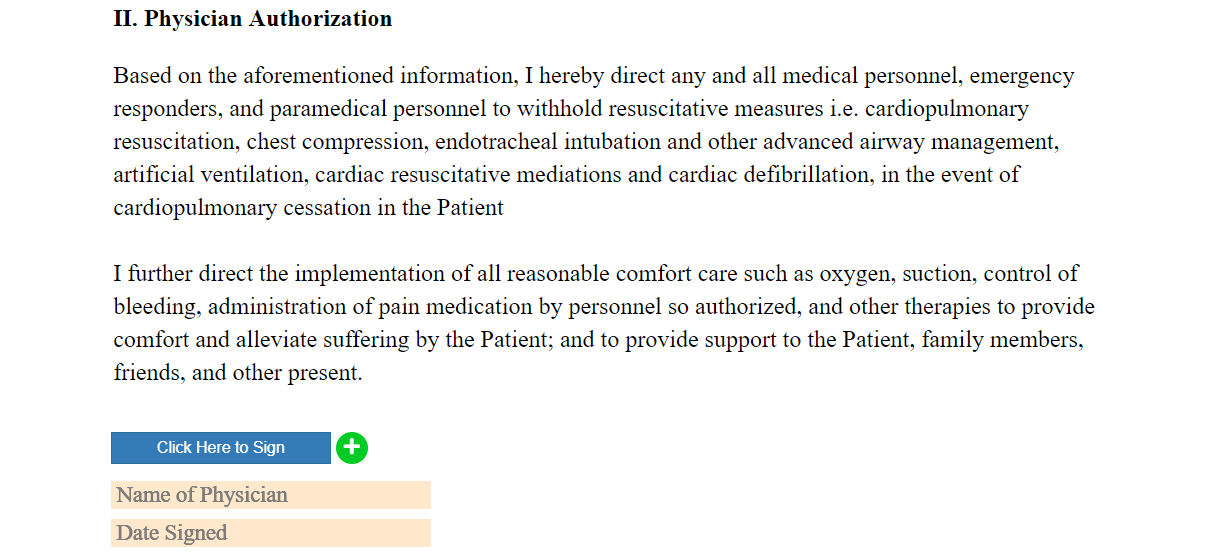Fillable Form DNR (Do Not Resuscitate)
A Do Not Resuscitate Form or DNR is a document used to order a healthcare provider that a patient or person does not want to receive cardiopulmonary resuscitation (CPR) when in a major injury or critical condition.
Fill and sign DNR (Do Not Resuscitate) online and download in PDF.
What is a Do Not Resuscitate Form?
A Do Not Resuscitate Form is used by terminally ill individuals who do not want to be saved or brought back to life via Cardiopulmonary Resuscitation (CPR), defibrillation, or other life-saving or life-sustaining medical procedures. It is used by elderly people and individuals who are suffering from a health condition and do not see a path towards a cured condition. People who want to stay off life-support in the event of a coma or major injury or illness may also use the form.
By definition, a Do Not Resuscitate order, also known as DNR, no code, or allow natural death, is a legal order in written or verbal form, depending on a country or state, that prevents medical interventions when a person requires life-support or his or heart stops beating.
There are laws that govern resuscitation in every state and they differ from one state to another. In general, the law requires that the patient complete and authorize the Do Not Resuscitate form by signing it with his or her doctor. In some cases, it should be notarized. Furthermore, witnesses may be required to validate the document.
A doctor or hospital should have a copy of the completed and signed Do Not Resuscitate form of a patient. For patients who ordered a do not resuscitate procedure may consider wearing a medical bracelet or necklace that indicates their decision. Doing so would notify medical responders during an emergency in a non-hospital setting.
Before completing and signing a Do Not Resuscitate document or form, a patient must speak with his doctor or healthcare team about his or her decision. After the talk, the document may be completed in the hospital or a private place where the patient is comfortable and can think coherently. If his or her doctor does not want to follow a patient’s wish, the doctor may transfer him or her to another doctor who will carry the instructions. Nevertheless, when a patient changes his or her mind and requests life-support or life-saving procedures, he or she may talk to the doctor or healthcare team to withdraw the decision. The family or caregiver of a patient should consistently be informed of all decisions at all times. In addition, all documents that assert the DNR should be destroyed.
Take note that the Do Not Resuscitate document does not cover all medical interventions. It is but a part of a more comprehensive medical care plan. Different medical procedures, such as chemotherapy, the use of drugs, and laboratory tests, may still be conducted. The DNR only relates to CPR when blood flow or breathing stops. CPR procedures may include mouth-to-mouth breathing and pressing on the chest, electric shock to restart the heart, the use of breathing tubes to open the airway, and the use of medicines.
How to fill out a Do Not Resuscitate Form?
Get a copy of DNR (Do Not Resuscitate) template in PDF format.
The legal requirements and content of a Do Not Resuscitate document vary from one state to another, depending on their laws. Nevertheless, A DNR document is typically just a one-page file that is easy to prepare and execute. It may be included in a patient’s healthcare directives or living will, which restricts a patient’s right to food, water, and assisted breathing in a terminally ill state.
For your convenience, we have a Do Not Resuscitate form that you can fill out, sign, and print. To answer it accurately, you may use the guide below.

Introduce the patient by providing his or her full legal name, as it appears on all medical records on file.

Write a note that confirms the patient’s request to order all medical personnel to abstain from all attempts to resuscitate him or her and allow a natural death. The section must indicate the state the patient lives.

The first section, Patient Request, should clearly define all of the patient’s wishes regarding CPR procedures.
For it to be valid, he or she should sign and date the section. This process can be done in front of witnesses or a notary public.

The second section, Physician Authorization, indicated the approval of the doctor who is in charge of the patient’s health. This section informs all medical personnel that the physician commands to withhold any resuscitative measures.
The doctor must sign, print his name, and put the date on the spaces provided to certify the DNR form.
Start filling out a DNR (Do Not Resuscitate) sample and export in PDF.
Frequently Asked Questions About A Do Not Resuscitate Form
Why do people get Do Not Resuscitate forms?
People who feel that they do not want to be given Cardiopulmonary Resuscitation (CPR), a procedure used to restore heart-lung function in the event of life-threatening emergencies, should make their wishes known. Their wishes must be carried out in the Do Not Resuscitate Order or DNR form.
Many people feel strongly about this subject and do not want to be given CPR in the event of cardiac or respiratory arrest even though they still have a reasonable quality of life at the moment. This decision is based on many reasons, such as:
- They are at the end of their life or nearing it and do not want to go through a traumatic resuscitation.
- They have a chronic disease that cannot be treated with CPR. In that case, resuscitating would only lead to more suffering and pain.
- They may not want to prolong the dying process (for example, I don't want my life prolonged if I cannot think or function on my own).
- They may not want to become a burden on their loved ones as a result of CPR, which can be very invasive and prolong life in uncomfortable ways.
Other reasons people get a Do Not Resuscitate Form are religious beliefs, family wishes, or personal values. It is important to note that anyone, regardless of age, can make these decisions for themselves.
What are the benefits of a Do Not Resuscitate Form?
The benefits of having a Do Not Resuscitate Form are that you will not be stuck with treatments you do not want, save money on hospital bills, and shorten your hospital stay.
If you have a Do Not Resuscitate Form in place, the paramedics will not attempt to resuscitate you in the event of cardiac or respiratory arrest even if your heart is beating or you are breathing on your own. Otherwise, the paramedics would perform CPR and try to prolong your life no matter what.
However, a Do Not Resuscitate Form does not mean you cannot receive life-saving measures should they become necessary. It includes artificial means, such as intubation (inserting a breathing tube) even if you are brain dead or completely incapacitated. It could potentially result in significant suffering, prolonged hospitalization, and enormous costs that are not reimbursable by any insurance company.
A Do Not Resuscitate Form allows you to die with dignity and helps your family avoid the stress of making such a decision.
What are the disadvantages of a Do Not Resuscitate order?
There are actually no disadvantages associated with having a Do Not Resuscitate Form in place.
However, if you wish to die naturally and not prolong your suffering when you are ill, you may not get what you want. It is because the doctor or physician will not know your wishes unless you let your family know. It is the importance of a Do Not Resuscitate (DNR) Order. You can write down your wishes in your dying state, and you get to decide for yourself.
What is the disadvantage of a Do Not Resuscitate Form?
The disadvantage of having a Do Not Resuscitate Form is that your family members may experience guilt, grief, and anger towards your decision. It is because they may feel that they cannot save your life when they have the chance to through CPR.
It may be necessary to involve your family with your decision-making process, so you will know how they feel about it.
However, if you wish to die naturally and not prolong your suffering when you are ill, you may not get what you want. It is because the doctor or physician will not know your wishes unless you let your family know. It is the importance of a Do Not Resuscitate (DNR) Order. You can write down your wishes in your dying state, and you get to decide for yourself.
Who can have a Do Not Resuscitate Form?
Any adult capable of making medical decisions for themselves can sign this form, regardless of age. Even someone considered legally incompetent can sign their own Do Not Resuscitate Form as long as they are deemed capable of having sound decision-making by a mental health professional.
Your family's wishes or religious beliefs do not affect your right to make medical decisions for yourself. However, you may still involve your family in the decision-making process to have other perspectives regarding the matter.
Why would a doctor suggest a Do Not Resuscitate Order?
A doctor may suggest you have a Do Not Resuscitate Order because CPR and other life-saving measures can be extremely uncomfortable. They could result in pain, suffering, and fractured ribs during the process of chest compressions. It could potentially result in prolonged hospitalization and enormous costs that are not reimbursable by any insurance company.
A Do Not Resuscitate Order allows you to die with dignity and helps your family avoid the stress of making such a decision. It is a legal document that allows you to state your end-of-life wishes, specify whether or not you wish to sign consent for artificial life support in case of an emergency, and appoint someone to speak for you if you are unable because of physical or mental incapacity.
Where do you put the Do Not Resuscitate Form?
It is best to keep your Do Not Resuscitate Form with you at all times, such as having it carried in a wallet. However, you may place the form inside a fireproof box or lockbox if it is too cumbersome to carry around. If this method is chosen, make sure that your family knows where to find your Do Not Resuscitate Form should an emergency arise.
You may also place your Do Not Resuscitate Form in a safe deposit box at your bank or ask your lawyer to keep it for you. Simply supply them with a copy of your Do Not Resuscitate Form so that they know what to do with it should an unforeseen situation happen.
What is the rule for a Do Not Resuscitate Form?
Usually, the doctor or physician will resuscitate you if your heart stops beating or your brain function ceases to revive you.
However, if you have a Do Not Resuscitate Order, the doctors will honor it. They will declare you legally dead once your heart stops beating, and they will follow the Do Not Resuscitate Order. You do not have to worry about your life when this happens.
Who decides for a Do Not Resuscitate Form?
A Do Not Resuscitate Order, also known as a DNR form, is a legal document. It allows you to make the decision about your own health care and life if you are too sick or injured to speak for yourself. It can clarify your final wishes to your family and loved ones, as well as the doctors and physicians involved in caring for you.
It is important to discuss these matters with your family beforehand for them to understand what your wishes are when you cannot make decisions for yourself. This way, there will be no confusion. Before getting admitted into a hospital, make sure you have your Do Not Resuscitate Form on file with the hospital so they can honor your wishes for resuscitation if necessary.
There are instances when your doctor may decide for your Do Not Resuscitate Form without your consent if he or she deems it necessary. It usually happens when your body cannot handle resuscitation or if the damage is already too severe.
A Do Not Resuscitate Order is best obtained from a physician through a simple form. If you do not have a Do Not Resuscitate Order already, ask your doctor to write it for you and then sign it.
Can you cancel a Do Not Resuscitate Form?
Yes, you can cancel a Do Not Resuscitate Form.
If you have a Do Not Resuscitate Form on file with the hospital or if it is written in your medical records, it may be removed when you are stable enough to speak for yourself.
You may directly tell your doctor or the physician who signed your Do Not Resuscitation Form that you do not want him or her to follow your wishes anymore.
Can a doctor put a DNR decision?
It is possible for a doctor or physician to put a Do Not Resuscitate Order without your consent if he or she deems it necessary. However, the doctor should let you make the final decision and respect your wishes in all cases.
Why is a Do Not Resuscitate Form bad?
A Do Not Resuscitate Order is not necessarily bad. As long as you are conscious of your final wishes, it is better to make them known instead of leaving the decision up to someone else who may or may not agree with what you want.
Making a Do Not Resuscitate Form may relieve your loved ones the difficult decisions about your health care. A Do Not Resuscitate Forms can do a lot of good, but not everyone realizes the consequences of using one.
A Do Not Resuscitate Forms are essential to people who do not want to be revived if they suffer a major injury. For elderly patients, this document helps clarify their final wishes so there will be no confusion among family members when they cannot speak for themselves anymore.
When should a Do Not Resuscitate Form be discussed?
A Do Not Resuscitate Order is not something you discuss only before an operation or a major injury. Even healthy people should consider this option to leave their final wishes known to their loved ones.
If the patient dies unexpectedly, the family will have a hard time making decisions about what to do because they may be in emotional distress. A DNR Form would be helpful for everyone and ensure that no mistakes will be made with regard to the patient's final arrangements.
Is a Do Not Resuscitate Form right for me?
A Do Not Resuscitate Form must be tailored specifically based on your and your family's needs. Discuss this option with your doctor, nurse, or health care provider.
A Do Not Resuscitate Form has been around for centuries, but there is still some understanding involved before the patient desires to do this if they are in a hospital, nursing home, or assisted living facility. Using such a document should be discussed with your doctor, family members, and loved ones. It can allow you to feel more secure about your final wishes being met without any third-party conflicts.
You cannot decide what is right for everyone, so do not assume that using a Do Not Resuscitate Form would be the best option just because you think it can help your loved ones with decisions. However, it is better to have the form if necessary than to ignore your final wishes and have your loved ones decide that you would not want.
Can a family member revoke a Do Not Resuscitate Form?
Yes, a family member can revoke a Do Not Resuscitate Form if he or she has signed the document.
Some family members may feel that their loved one should be revived even if there is no chance of recovery, but the patient's wishes must be respected. A Do Not Resuscitate Form is designed to protect the patient's wishes, not the family's.
Therefore, an attorney or other representative who holds a Do Not Resuscitate Form must abide by the decisions of the person whose form it is. If you need to revoke someone else's DNR document so your relative can be revived, you should contact the attorney or representative first.
Is a Do Not Resuscitate Form legal?
Yes, a Do Not Resuscitate Form is legal as long as it is properly filled out and maintained. It is used to ensure that a person's final wishes are met.
A Do Not Resuscitate Order is legal because it fulfills the wishes of the patient. If you or your family members choose this route, inform everyone involved in your medical care that resuscitation should not be performed for any reason.
A Do Not Resuscitate Form may be illegal if the patient is pregnant yet she wants to withhold life-saving procedures. In such a case, the doctor may not honor the wishes of the patient for the best interest of the child.
Does my doctor need to know I have a Do Not Resuscitate Form?
Yes, your doctor needs to know that you have a Do Not Resuscitate Form to be aware of your wishes. Otherwise, the doctor will assume that he or she must do everything possible to resuscitate you.
Let your physician or doctor sign your Do Not Resuscitate Form. If you meet an accident and have major injuries, your doctor must inform the healthcare provider who rescues you about your Do Not Resuscitate Form.
Can a Do Not Resuscitate Form be used if I am unconscious and unable to communicate?
Yes, a Do Not Resuscitate Form can be used if you are unconscious and unable to communicate. It also applies if you are in cardiac arrest or terminally ill.
Is it ethical to not resuscitate?
Yes, it is ethical not to resuscitate if you are terminally ill or in a coma. However, your doctor still has his or her own opinion about this matter.
It can be difficult to make the choice that you want to stop treatment when there are no chances of recovery left. It will be tough for your family members as well because they are not ready to lose you.
The final decision would be made by your doctor, so tell him or her about your Do Not Resuscitate Form if you have one. The doctor will then know that there is no need to resuscitate you or do anything else.
What is the difference between DNR and DNAR?
DNR means "Do Not Resuscitate," meaning that your doctor will not try to resuscitate to revive you.
DNAR is a newer term, which stands for "Do Not Attempt Resuscitation." The medical staff will not initiate resuscitation efforts but can perform CPR if necessary.
Can a Do Not Resuscitate Form be ignored?
It is up to the doctor whether to ignore your decisions or not, but he or she cannot do anything against your wishes. However, make sure that you have signed and witnessed the form before handing it over to your medical care provider.
Is a Do Not Resuscitate Form legally binding?
Yes, a Do Not Resuscitate Form is legally binding as long as it is signed by you and witnessed. You can revoke the document if you wish.
There are some situations where your doctor does not have to abide by your decision, so do not presume that he or she will follow the Do Not Resuscitate Form. For example, if you are pregnant, your doctor may ignore your decision and do everything possible to save you and the baby.
How long is a Do Not Resuscitate Form valid?
There are two types of a Do Not Resuscitate Form — hospital and non-hospital.
A Hospital Do Not Resuscitate Form does not expire. It is issued by a doctor or physician that he or she signed with two adult witnesses. The adult witnesses may be other doctors working in the hospital. They must sign the Do Not Resuscitate Form as well.
A Non-Hospital Do Not Resuscitate Form is valid for 90 days. It is issued outside the hospital. If your doctor issued you a Non-Hospital Do Not Resuscitate Form outside the hospital, he or she must renew it every after 90 days.
You must update your Do Not Resuscitate Form as long as you are alive. Note that the form does not expire after your death or if it is up to date.
Can a healthy person get a Do Not Resuscitate Form?
Yes, a healthy person can get a Do Not Resuscitate Form if he or she does not want medical treatment for any health conditions. A doctor must issue the form, and it will be valid until you revoke it.
A Do Not Resuscitate Form is especially helpful in making end-of-life decisions. It helps avoid medical treatment that may cause more harm than good, such as CPR or intubation.
Can a spouse reverse a Do Not Resuscitate Form?
A spouse can reverse a Do Not Resuscitate Form if he or she signed it when the patient or doctor issued the form.
Is a Do Not Resuscitate Form a form of euthanasia?
A Do Not Resuscitate Form is regarded as passive euthanasia because the patient is choosing not to receive medical treatment to prolong his or her own life.
Euthanasia or mercy killing is taking the life of another person with his or her consent. It becomes passive euthanasia if you do not want to take life-prolonging measures and decide to pass away naturally.
Active euthanasia means taking the life of another person without his or her consent, such as administering a lethal injection to end your suffering.
Create a DNR (Do Not Resuscitate) document, e-sign, and download as PDF.
Related Articles:
Keywords: do not resuscitate form do not resuscitate template do not resuscitate do not resuscitate pdf DNR DNR do not resuscitate
















